- Submissions

Full Text
Modern Concepts & Developments in Agronomy
Soil Fertility Management in Cassava Cultivation
Olasanmi B1*, Mahamane ARO1,2, Omoniyi JO3 and Fregene M4*
1Department of Crop and Horticultural Sciences, University of Ibadan, Nigeria
2National Agricultural Research Institute of Niger Republic, Nigeria
3Department of Soil Resources Management, University of Ibadan, Nigeria
4African Development Bank, Immueble CCIA, Nigeria
*Corresponding author:Olasanmi B, Department of Crop and Horticultural Sciences, University of Ibadan, Nigeria Fregene M, African Development Bank, Immueble CCIA, Abidjan, Ivory Coast, Nigeria
Submission: July 23, 2025;Published: September 09, 2025

ISSN 2637-7659Volume15 Issue 3
Background
Soil fertility management is the process of conserving the physical state and nutrient status of the soil in a form that ensures good crop productivity. Soil fertility management, therefore, involves agricultural practices that are vital in ensuring adequate nutrient status in the soil for efficient crop production. These practices include the application of organic and inorganic fertilizers, mulching, biofertilizers and use of green manure. According to CARA Development Foundation (2024), cassava requires the three primary macronutrients (nitrogen, phosphorus and potassium) for good growth, but any fertilizer application must be based on soil test results. The best inorganic fertilizers for cassava are now NPK 20:10:10, NPK 15:15:15, and NPK 12:12:17 (Info Guide Nigeria) which can be applied between 6 and 8 weeks after planting. The amount applied should depend on soil test analysis results. It can be applied using the point application or circle method (which is most effective). The amount of fertilizer applied matters as overdose can lead to nutrient toxicity and antagonism, hence, the application should be strictly based on soil test results.
Cassava Plant Nutrient Requirement
Although cassava can be cultivated with minimal inputs [1], optimal yields are recorded from fields with average soil fertility levels and regular moisture availability for food crop production. According to Azcón-Aguilar et al. [2], mycorrhizal inoculation enhanced growth of cassava plantlets. They also recommended that appropriate plant cultivar/AM fungi combinations should be selected for optimum growth of the plant. Mbassi et al. [3], also reported that arbuscular mycorrhiza fungi inoculation greatly improved growth of cassava and increased its yield and nutritional properties while reducing the antinutrients in the storage roots of the evaluated varieties. Hence, cassava’s ability to grow in low fertility soils may be due to mycorrhizal fungi which are present in nearly all natural soils and infect the roots of the great majority of plants, including the major food crops. Mycorrhiza lives symbiotically with any plant it infects. Cassava exudes simple sugars from its roots which mycorrhiza utilizes for its growth and in turn mobilizes P and other nutrients for the use of the plant. In normal soils, cassava roots are almost always infected with mycorrhizal fungi.
There is a relationship between nutrient supply and yield with the most limiting nutrient dictating the level of yield. Continuous cassava cultivation without nutrient inputs will deplete the soil’s nutrient status since nutrients are removed from the field in the harvested products. This fact is not limited to cassava alone; it is also true for other crops. However, if adequate amount of nutrients is applied annually to compensate for this nutrient removal, then the fertility status of the soil can be maintained [4]. Responses to macro-nutrients vary, with cassava responding most to P and K fertilizer application. High N fertilizer application (more than 100kg of actual N/ha) may result in excessive foliage production at the expense of storage root development. Fertilizer should be applied within the first 60 days of growth. Application should be based on soil fertility level and the nutrient requirements of the cassava variety, therefore, recommendations based on soil testing results should be strictly adhered to.
Macro and micronutrient requirements based upon target yields
Soil fertility can be described in terms of its nutrient status and the ability to supply these nutrients in the required amount and right proportion for the use of plants growing in the soil. The essential nutrients involved in the metabolism of the plants are C, H, O, N P, K, Ca, Mg, S (macronutrients) Fe, Mn, B, Zn, Cu, Mo and Cl (micronutrients). Macronutrients are required in large amounts. The absorption of these nutrients by plants depends on some external factors such as availability of the nutrients, soil humidity, aeration, organic matter content and pH [5]. The approximate classification of soil chemical characteristics according to the nutritional requirements of cassava is shown in Table 1. The estimated nutrients extracted by cassava for two levels of yield is shown in Table 2.
Table 1:Approximate classification of soil chemical characteristics according to the nutritional requirements of cassava.
1. pH in H2O. 1:1
2. OM=Walkley and Black method.
3. Al saturation=100xAl(Al+Ca+Mg+K) in meq/100g.
4. P in Bray II; K, Ca, Mg and Na in 1N NH4-acetate; S in Ca phosphate.
5. B in hot water; and Cu, Mn, Fe and Zn in 0.05 N HCl+0.025 N H2SO4.
Source: Howeler, 2012b
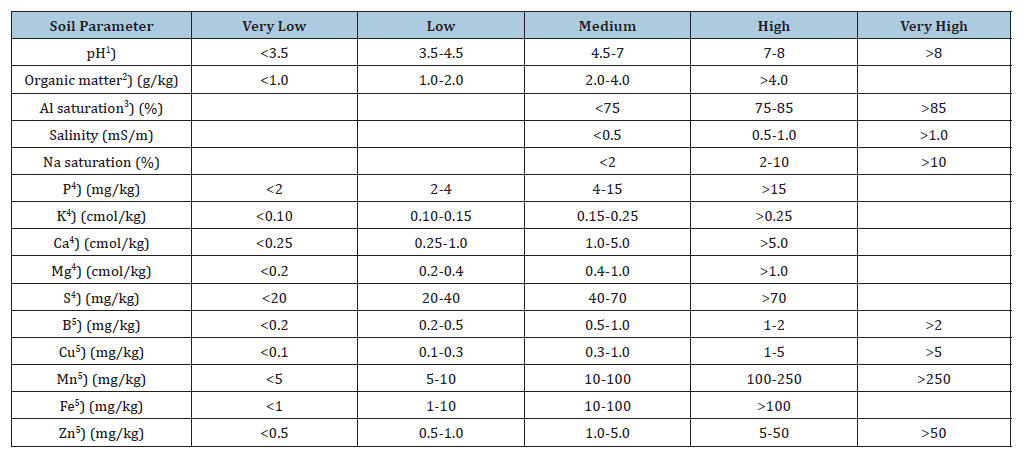
Table 2:Extracted nutrients by cassava according to yield.

Fertilizer type
Inorganic fertilizer: Most commercial inorganic fertilizers contain at least one of the primary elements in a form available to plants in a specified amount. The grade of a fertilizer is the nutrient content in weight of N, P2O5 and K2O in the order N-P-K. For example, a grade of “NPK 12-12-17” indicates a fertilizer containing 12% N, 12% P2O5, and 17% K2O (CIAT, 2002). The commonly used fertilizers are straight fertilizer (containing only one nutrient e.g. urea, superphosphate, muriate); compound fertilizer (containing two or more nutrients); granular fertilizer (in form of particles); and liquid or fluid fertilizer (which includes fertilizers that are partially soluble, clear liquids and liquids containing solids in suspension).
Soil types related to Fertilizer Use Efficiency (FUE)
The ability of any soil to retain nutrients and make such nutrients available for plant use depends on soil type. Any soil with high organic matter content and clay particles will retain soil nutrients more than depleted soil having low organic matter content. The organic matter and clay particles are the colloids on which the cations are adsorbed. The higher the organic matter content, the higher the Effective Cation Exchange Capacity (ECEC) of the soil. Soil with high ECEC will ensure that the nutrients are readily available for the plant roots. This will enhance the efficiency of fertilizer use of plants. Fertilizer added to soil depleted of organic matter will be leached or washed away from the soil within a very short period because soil organic matter acts as a binding agent in the soil.
Cost: Cost of fertilizer depends on the type, nutrient content, source and market factors. The cost of a bag (50kg) of NPK 15-15- 15 fertilizer is currently about N45,000 to N55,000 in the open market. The cost may vary from one location to the other. Cost of transportation should be taken into consideration when making arrangement to procure fertilizer.
Fertilizer recommendation
Calculation of fertilizer rate: The quantity of inorganic fertilizer applied on a farm depends on the amount of nutrients available in the soil which that soil can supply to the plants. The quantity of fertilizer applied is the difference between the nutrient available in the soil and the standard critical level of the nutrient required for the growth of the crop. This factor is determined in the laboratory through chemical analysis. The quantification of available nutrients is expressed in the results of the laboratory analysis as g/kg, mg/kg and cmol/kg of dry soil. This can be converted to kg/ha.
Example:
Consider soil density (d) of 1.3g/cm3. The average depth of the ploughed area of the soil within the average depth of function of the root system of the crop e.g. in cassava, it is 20cm.
weight of soil (Ps)=Volume of soil (Vs in cm3) x density (d in g/ cm3)
Vs=L x B x P
L=Length
B=Breadth
P=depth
I ha=100m x 100m
I ha=10000cm x 10000cm
In this case:
Vs=10000cm x 10000cm x 20cm=2 x 109cm3
Ps=2 x 109cm3 x 1.3g/cm3 x kg/1000g=2.6 x 106kg
Therefore, cmol/kg dry soil can be expressed in kg/ha.
Using potassium (K) as nutrient of interest:
Equivalent gram (eq) of K=molecular weight in gram/valency
Eq K=39/1=39g
1meq K=39g/1000=0.039g
Therefore, we have
0.039Kg per 100g of dry soil
XKg of K in 2.6x106Kg/ha:
1meq K/100g=0.039gK=1014Kg/ha
If laboratory result is 0.08 meq/100g of dry soil
Therefore,
The available nutrients in the soil are calculated using 1 meq K/100g soil=1014Kg K/ha (for d of 1.39g/cm3)
For 0.08 meq/100g soil:
X kg K/ha gives
X=81.12kg K/ha.
If the critical level for K in the soil is 0.15 meq/100g soil
Therefore
1 meq K gives 1014kg K/ha for soil density of 1.39cm3:
Therefore, X kg K/ha:
X=152kg K/ha
The difference between 152kg K/ha (0.15meq/100g) and 81.12Kg K/ha (0.08meq/100g) is what we need to add in supplement as fertilizer i.e. 71kg K/ha.
When data is represented in ppm, this can be converted into kg/ha.
Using phosphorus (P) as nutrient of interest:
1ppm is: 1kg P in 1x106kg soil
X kg P in 2.6x106kg/ha soil
X=2.6kg P/ha
Therefore:
1ppm P=2.6kg P/ha
For example, if we have a laboratory result of 3.0ppm of P, then the available P in the soil is:
1.0ppm P is 2.6kg P/ha
3.0ppm P is in X Kg/ha
X=7.8kg P/ha
If the critical level for P in soil is 8.0ppm:
X=20.8Kg P/ha. The difference between this value and 7.8Kg/ ha for 30ppm is the amount of fertilizer that will be needed to supplement the shortfall in P in the soil.
The calculations from meq/100g or ppm from soil analysis on basis of kg/ha will determine what amount of fertilizer needs to be added to make up for shortfall in the soil.
Fertilizer calculation
Fertilizer recommendations are expressed in kilograms of nutrients per hectare (kg/ha) in the order N-P2O5-K2O (or N-P-K). Based on result of field trials or results of soil analysis, fertilizer rates are formulated.
Example 1: Calculation for combination of single element fertilizers [6]:



Given a recommended rate of 80N-30P2O5-30K2Okg/ha, apply fertilizers using urea (45%N), triple superphosphate (45%) and muriate of potash (60%):
Example 2: Calculation for combinations of single nutrients and compound fertilizers
Given a 15-15-15 fertilizer and urea (45%N), apply at the rate of 80-30-30kg/ha.
Phosphorus and potassium must be calculated first.

Therefore, 200kg of a 15-15-15 compound fertilizer supplies only 30kg of N per ha. This means one must yet supply another 50kg of N by urea.

Conversions of the rate of nutrient application (kg/ha) for N, P, K into their corresponding values for different fertilizers are presented in Table 3, Table 4 & Table 5, respectively. Cassava farmers will most likely use combination of single element and compound fertilizers. These fertilizers may be applied separately or mixed and applied in a single operation. It is more convenient to mix fertilizers because application is easier, especially on large, mechanized farms. However, not all fertilizers can be mixed. For example, strong basic fertilizers such as lime should not be mixed with urea, otherwise the nitrogen may be lost as ammonia. When one needs to apply nitrogen and phosphorus, do not mix ammonium sulphate with rock phosphate or urea with superphosphate. If this is done, the elements will react against one another and one of them becomes less effective [5]. Seek the advice of experts in this regard or purchase pre-mixed fertilizers. Fertilizer can be mixed either in batches using a mixer or manually, but the mixing should be thoroughly done to ensure even distribution of all the nutrients.
Table 3:Conversion of pure elements to quantities of nitrogen fertilizer.

To calculate the amount of fertilizer required, multiply the rate of N (Nitrogen) application by conversion factors of 5.0 for ammonium sulfate, 2.2 for urea, 4.0 for aqua ammonia, 1.2 for anhydrous ammonia.
Table 4:Conversion of pure elements into quantities of potassium fertilizer (kg/ha).
-To calculate the amount of fertilizer required, multiply the rate of
-P2O5 (phosphorus) application by conversion factors of 5.0 for
-Ordinary superphosphate, 2.2 for triple superphosphate

Table 5:Conversion of pure elements to quantities of phosphorus fertilizer (kg/ha).
- To calculate the amount of fertilizer required, multiply the rate of
- K2O (potassium) application by conversion factors of 1.7 for
- Ordinary superphosphate, 2.0 for triple superphosphate

Diagnosing Nutrient Deficiency
To diagnose nutritional problems, it is very important to analyze a defined indicator tissue at a specific time in the growth cycle. In most cases, for cassava, the best indicator tissue is the Youngest Fully Expanded Leaf (YFEL) blade collected 3-4 months after planting. However, if this happens to be during a long and severe drought, it is better to wait for the next wet season and sample the same indicator tissue about 2-3 months after the onset of rains. The nutrient concentrations in the YFEL blades determined in this manner can be compared with the tables of critical nutrient concentrations in cassava plant tissue, or with the nutrient concentrations corresponding to specific nutritional states of the plant [7]. A correct diagnosis of nutritional problems is the first and most important step in determining the most suitable way to supply the correct fertilizers to obtain and maintain high yields of cassava.
The principal deficiency symptoms of cassava are described as follows:
Nitrogen
Reduced growth: leaves are slightly lighter green in color with uniform chlorosis throughout the plant; deficiency starts in the lower leaves but extend rapidly to all parts of the plant; premature dropping of leaves (Figure 1).
Figure 1:Symptoms of Nitrogen deficiency
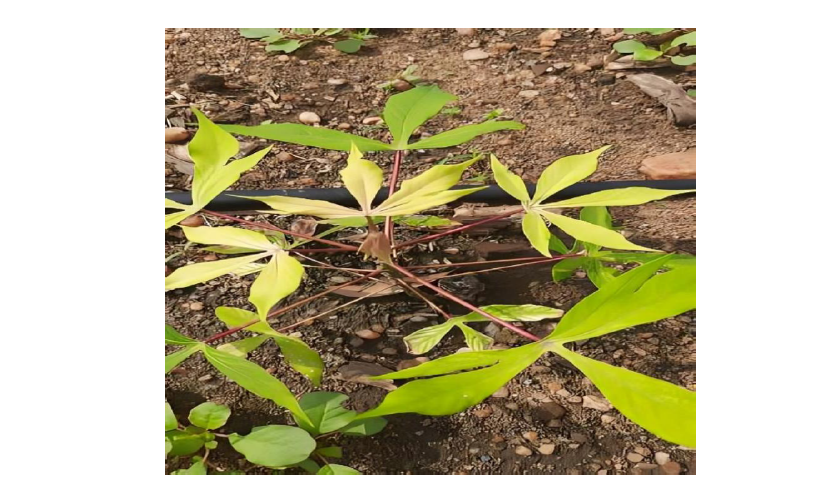
Phosphorus
Reduced growth of the plant: reduced leaves, thinner stems; under severe conditions, lower leaves turn chlorotic (yellowing) which may turn necrotic (dead tissues) and fall off (Figure 2).
Figure 2:Symptoms of phosphorus deficiency.
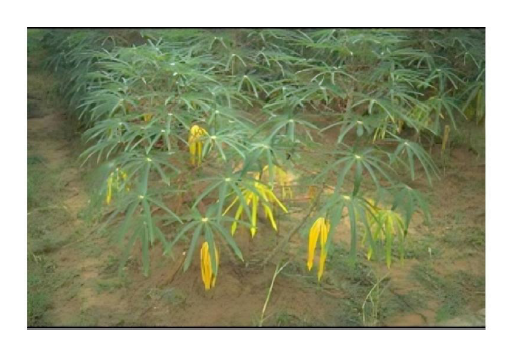
Potassium
Reduced growth of the plant; small leaves; under severe conditions purple spots, chlorosis and necrosis of the apices and borders of the lower or intermediate leaves; necrosis of the petiole or stem tissues (Figure 3).
Figure 3:Symptoms of potassium deficiency [14].
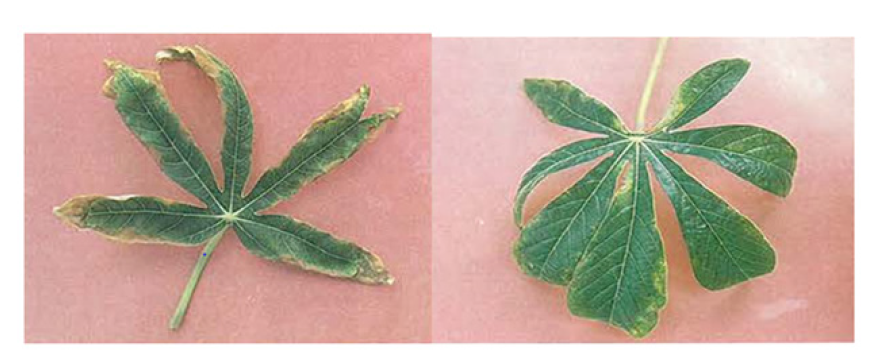
Calcium
Reduced growth of the roots; small and deformed upper leaves (Figure 4).
Figure 4:Symptoms of calcium deficiency [14].
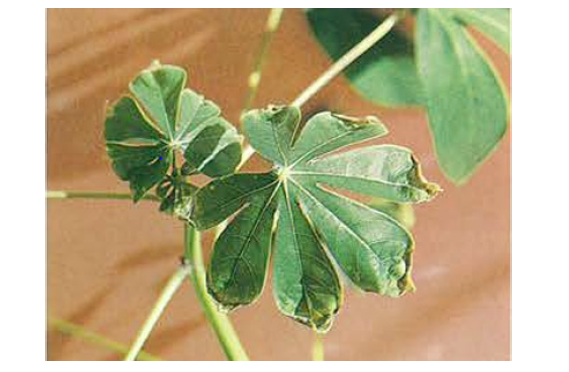
Magnesium
Interveinal chlorosis in lower leaves and intermediate part of the plant, certain reduction in plant height (Figure 5).
Figure 5:Symptom of magnesium deficiency [14].
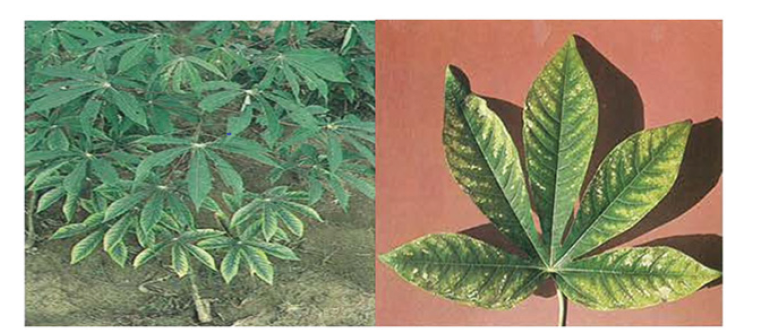
Sulphur
Uniform chlorosis of the upper leaves; sometimes similar symptoms are observed in the other leaves on the plant (Figure 6).
Figure 6:Symptom of sulphur deficiency [10].
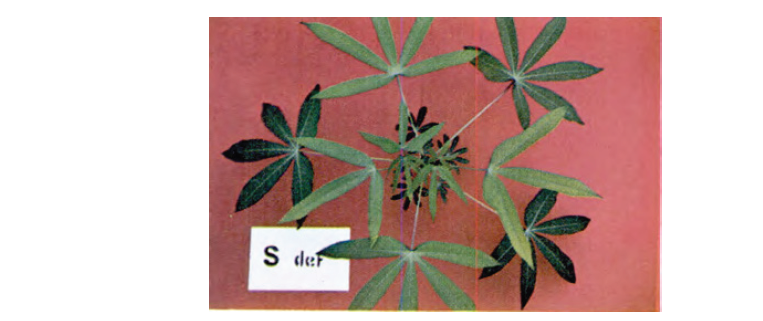
Boron
Reduced plant height, internodes and short petioles; small and deformed young leaves; Completely extensive purple-gray spots in the leaves, reduction of the development of the lateral roots (Figure 7).
Figure 7:Symptom of boron deficiency [14].
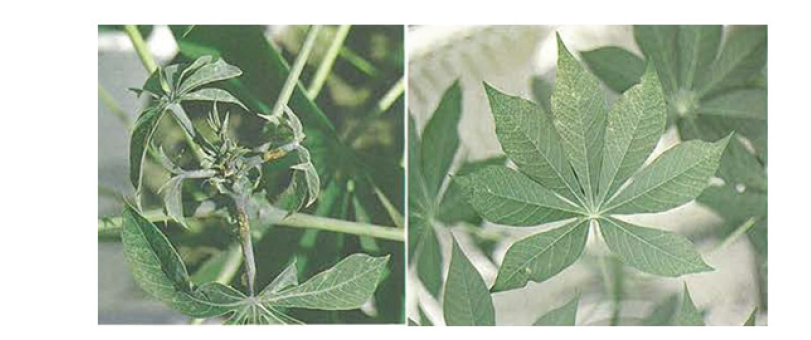
Iron
Uniform chlorosis of the upper leaves and petioles, which could turn white under severe conditions, reduced plant growth and small young leaves without deformation (Figure 8).
Figure 8:Symptom of iron deficiency [14].
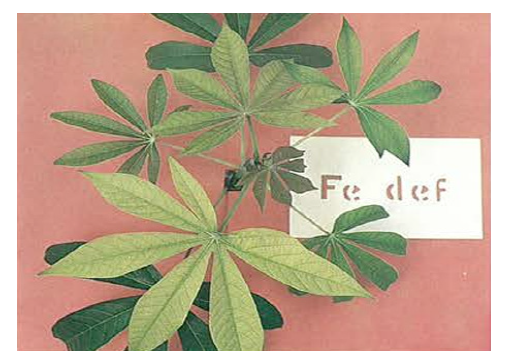
Manganese
Interveinal chlorosis of the upper or intermediate leaves; uniform chlorosis in severe conditions, reduced growth of the plant; small young leaves without deformation (Figure 9).
Figure 9:Symptom of manganese deficiency [15].
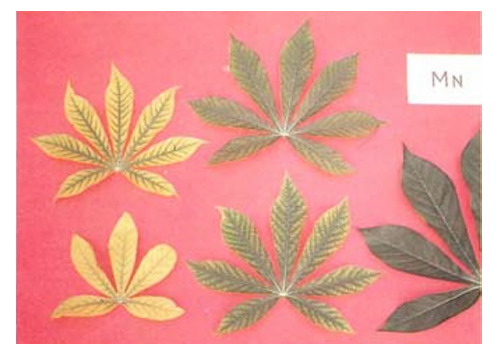
Zinc
Interveinal light-yellow spots in young leaves which shrink over time; development of chlorosis in the tip of the shoot under severe conditions; necrotic spot of the lower leaves; reduced growth of the plant. Many times, symptoms of zinc deficiency can be confounded with mite attack (Figure 10).
Figure 10:Symptom of zinc deficiency [15].
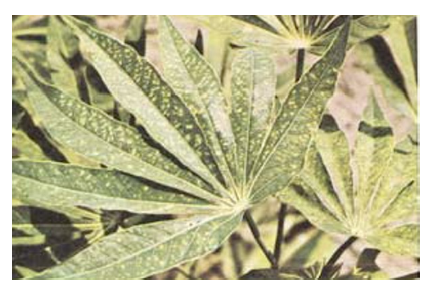
Nutrient Toxicity
Soil fertility management in cassava production should take into consideration adequate and balanced supply of nutrients to satisfy the needs of the plants avoiding toxic concentrations [5]. There is always needed to confirm diagnosis based on deficiency or toxicity symptoms by soil or plant tissue analyses so that adequate recommendation can be made. This will ensure that adequate quantity of fertilizer is added to the soil. Excess of a particular nutrient can lead to antagonism, a situation whereby some nutrients available in the soil are rendered unavailable to the plants. Fertilizer application should therefore be carried out following the recommendation based on soil fertility analytical result. The principal symptoms of toxicity in the cassava crop are:
Aluminum toxicity
This is caused by low soil pH. The symptoms of Al toxicity are reduced plant height and growth of roots and chlorosis of the old leaves (Figure 11).
Figure 11:Symptom of aluminium toxicity [14].
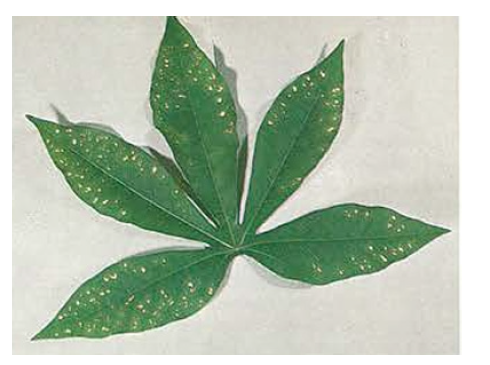
Boron toxicity
Necrotic spots of the old leaves especially along their border (Figure 12).
Figure 12:Symptom of boron toxicity [14].
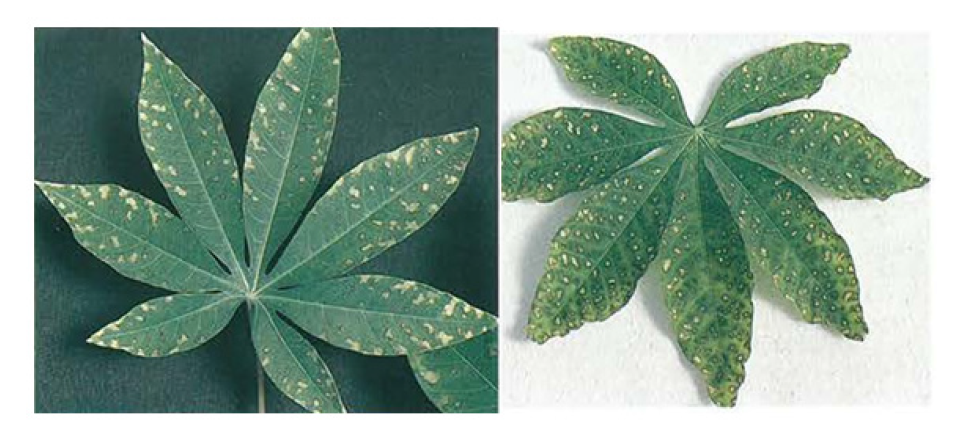
Manganese toxicity
Chlorosis of the old leaves with purple-brown or dark spots along the veins; the leaves turn flaccid and drop (Figure 13).
Figure 13:Symptom of manganese toxicity [14].
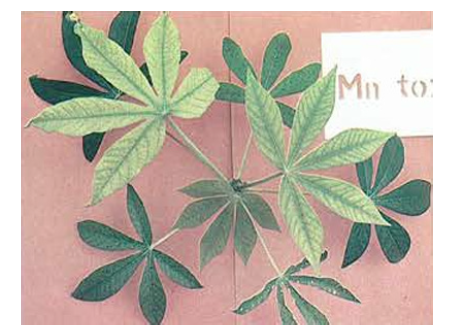
Mode of Application: Split or Single Dose
Cassava fertilizer requirements can be applied as a single dose or twice (split) during the first 60 days of plantings. Single or split dose application depends upon the nature of the fertilizer with split application being used when the fertilizer is easily leached or can be lost through evaporation. In mechanised agriculture, fertilizer is applied as a single dose at planting. In small holder or semi-mechanised agriculture, fertilizer is often applied at 4 weeks after planting for single dose application or at 4 and 8 weeks after planting for split application. During plant growth, symptoms of nutrient deficiency can be corrected through the application of additional foliar or granulated fertilizer as top dressing. According to Hauser et al. [8], N-P-K compound fertilizer should be applied in three phases: First application at 4 to 6 weeks after planting,second one between 10 and 12 weeks after planting and the final application between 16 and 20 weeks after planting.
Fertilizer application methods
Figure 14:Application of fertilizer in half-moon method [8].
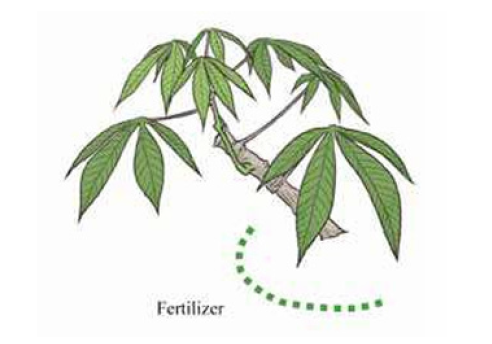
Highly soluble fertilizers can be broadcast and incorporated into the soil. Such fertilizers can also be applied in a band (5-10cm away from the plant in the front or by the side). Band (placement) application concentrates the nutrients near the cassava plant to enhance its growth rather than those of the weeds thereby reducing weed competition. Placement application is most practical in nonmechanized agriculture. According to Hauser et al. [8], fertilizer can be applied by scraping a half-moon shaped furrow of 20cm from the base of the cassava plant and incorporate the correct measure of fertilizer (Figure 14). In mechanized cassava farming, fertilizer application is at the time of planting using a fertilizer buggy attached to the planter. Soil amendments are necessary in highly acidic soils [9]. This could be addressed by application of chemicals such as lime, rock phosphates, basic slag, gypsum and elemental sulphur which can be broadcast using machine to ensure even distribution. The fertilizer can then be incorporated with a disc harrow (Figure 15). Large applications of lime should be divided such that the first half can be ploughed in rather deeply and the second half incorporated shallowly with a disc harrow [5].
Figure 15:Some common measuring units for fertilizer: A soda bottle cover which can hold about 6 g of fertilizer (Left); Water bottle cover which can hold about 8 g of fertilizer (Left) [8].

Organic fertilizers: Commonly used organic fertilizer is produced from waste and animal dungs cured over a period. The composted material may and may not be fortified with some inorganic fertilizers. Composted materials fortified with inorganic fertilizers is known as Organomineral fertilizer e.g. Pace Setter Organomineral fertilizer [10]. Any farmer interested in producing organomineral fertilizer can acquire the knowledge through capacity building.
Application rate: The application rate of organomineral fertilizer is based on the nutrient requirement of the soil. However, there is always residual effect when manure is used because mineralization of the organic residue continues even after application. Organic fertilizer is applied by broadcast method [11]. Broadcast application distributes nutrients more uniformly around the whole root system, but the application is more diluted. This method encourages rapid weed growth and competition between weeds and cassava plants for the nutrients.
Nutrient Recycling
Soil fertility management basically entails renewal, replenishing and recycling of nutrients [12]. It has been shown that cassava could be grown on the same land for 25 years while maintaining high root yields of 30-40t/ha in Thailand when adequate amounts of NPK fertilizers (100kg N+50Kg P2O5+100Kg K2O/ha) were applied annually and plant tops were incorporated into the soil before each new planting. However, when no fertilizers were applied and plant tops were removed from the field, cassava yields dropped from about 30t/ha in the first year to 7t/ha in the sixth year of cropping due to nutrient depletion, especially that of K [4]. Farmers should try to minimize nutrient export from their farms. Each cassava root taken out of the field contains a certain quantity of each of the soil nutrients [13]. Cassava farmers should therefore retain foliar part, non-plantable stems and stump on the field at harvest and if possible, process the cassava storage roots to an extent on the field [14]. In a situation where farmers have access to animal manure or can produce compost, it can serve as organic matter which stimulates micro-organisms in the soil, improves soil structure, aggregate stability, and water and nutrient-holding capacity [15].
Composting
Compost can be built by collection of organic materials and transfer them into a pit or a big container to be used for composting. The materials can be arranged in layers at intervals of about 2 weeks with all the materials used each time. This will enable the farmer make use of materials collected over time. Also, the farmer may compost materials gathered at any given time in a separate pit or container. The composting should be carried out under shade and protected from rainwater. Some old compost should be added to the materials to act as starter. The compost material should be moist throughout the period of composting to ensure optimal activity of the microbes. Most of the municipal wastes constituting nuisance in the public are potential composting materials. One of the authors of this paper has been using kitchen waste from his house and poultry droppings as source of compost on his research farm and has been cultivating cassava on the same piece of land for 17 years with storage root yield relatively stable over the period. It is counter-productive to export nutrients from the soil, use the organic waste to constitute nuisance in the public and go ahead to procure inorganic fertilizer with hard earned income to improve fertility of the same soil mismanaged.
Materials for composting
Materials for composting include among others, plant residues e.g. cassava peel, stump and plant tops; weeds, most especially the common ones such as Tithonia diversifolia and Chromolaena odorata; animal dung, poultry waste, decomposable household wastes, market and industrial wastes (rice husk, wastes from Breweries etc).
Method of application
The compost should be incorporated into the soil during land preparation by broadcast method. It should be incorporated into the soil by plough and harrow.
Other soil fertility management practices
Mulching: This involves covering the soil surface with plant materials. Mulching improves the fertility of the soil, increases the ability of the soil to hold sufficient water for plant growth and reduces erosion and weed problems and a source of soil organic matter when the materials decompose. Mulching involves very large amounts of plant foliage. Dead plant foliage can be used as ‘dead mulch e.g. leguminous plants, crop residues etc. Live mulches can also be grown. For example, during fallow periods, Mucuna pruriens var. utilis can be grown on land selected for growing cassava in the next season.
References
- Parmar A, Sturm B, Hensel O (2017) Crops that feed the world: Production and improvement of cassava for food, feed and industrial uses. Food Security 9: 907-927.
- Azcón-Aguilar C, Cantos M, Troncoso A, Barea JM (1997) Beneficial effect of arbuscular mycorrhizas on acclimatization of micro propagated cassava plantlets. Scientia Horticulturae 72(1): 63-71.
- Mbassi MGG, Djontzo TE, Essono DM, Adamou S, Fokom R, et al. (2024) Growth, profitability, nutritional and anti-nutritional properties of seven Manihot esculenta Crantz (cassava) varieties as affected by arbuscular mycorrhizal fungi. Heliyon 10(17): e36371.
- Howeler RH (2012a) Effect of cassava production on soil fertility and the long-term fertilizer requirements to maintain high yields. In: RH Howeler (Ed.), The Cassava Handbook: A Reference Manual based on the Asian Regional Cassava Training Course, Held in Thailand, CIAT, Cali, Colombia, pp. 411-427.
- CIAT (2002) Cassava in the third millennium: Modern systems of production, processing, utilization and marketing. In Ospina and Ceballos (Eds.), CIAT, Colombia.
- Kang BT (1995) Fertilizers: Definition and calculations. Research Guide 24, IITA, Ibadan, Nigeria, pp. 28.
- Howeler RH (2012b) Diagnosis of nutritional problems of cassava. In: RH Howeler (Ed.), The Cassava Handbook: A Reference Manual based on the Asian Regional Cassava Training Course, held in Thailand. CIAT, Cali, Colombia, pp. 411-427.
- Hauser S, Wairegi L, Asadu CLA, Asawalam DO, Jokthan G, et al. (2014) Cassava system cropping guide. Africa Soil Health Consortium, Nairobi. p. 64.
- CARA Development Foundation (2024) Good agronomic practices for cassava high yield in Nigeria.
- Centro Internacional de Agricultura Tropical (CIAT) (1985) Nutritional disorders of the cassava plant: Study guide to be used as a complement to the audio tutorial unit on the same subject. Scientific content: Reinhardt Howeler, Colombia, p. 36.
- Howeler RH (2002) Cassava mineral nutrition and fertilization. In: RJ Hillocks, MJ Thresh and AC Bellotti (Eds.), Cassava: Biology, Production and Utilization. CABI Publishing, Wallingford, Oxon, UK, pp. 115-147.
- Howeler RH (2012c) Importance of mycorrhiza for phosphorus absorption by cassava. In: RH Howeler (Ed.), The Cassava Handbook: A Reference Manual based on the Asian Regional Cassava Training Course, held in Thailand, CIAT, Cali, Colombia, pp. 411-427.
- Infoguide Nigeria (2023) Top 15 NPK fertilizers for cassava in Nigeria.
- Asher CJ, Edwards DG, Howeler RH (1980) Nutritional disorders of cassava (Manihot esculenta Crantz). Centro Internacional de Agricultura Tropical (CIAT), Cali, Colombia, pp. 54.
- Lozano JC, Bellotti A, Reyes JA, Howeler R, Leihner D, et al. (1981) Field problems in cassava. Cali, Colombia, p. 208.
© 2025 Olasanmi B and Fregene M. This is an open access article distributed under the terms of the Creative Commons Attribution License , which permits unrestricted use, distribution, and build upon your work non-commercially.
 a Creative Commons Attribution 4.0 International License. Based on a work at www.crimsonpublishers.com.
Best viewed in
a Creative Commons Attribution 4.0 International License. Based on a work at www.crimsonpublishers.com.
Best viewed in 







.jpg)






























 Editorial Board Registrations
Editorial Board Registrations Submit your Article
Submit your Article Refer a Friend
Refer a Friend Advertise With Us
Advertise With Us
.jpg)






.jpg)














.bmp)
.jpg)
.png)
.jpg)










.jpg)






.png)

.png)



.png)






